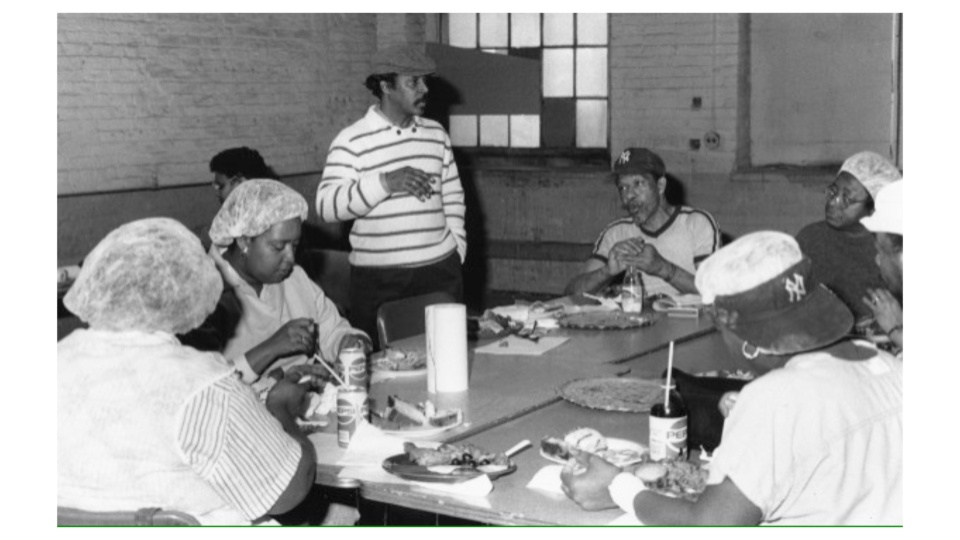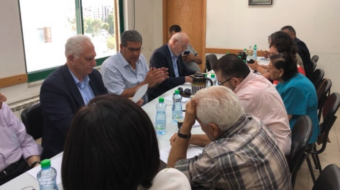
Huey Newton, Fred Hampton, Angela Davis, Assata Shakur, and Claudia Jones—they’re some of the most monumental names in mid-20th century Black history. They struggled for the liberation of Black people, the oppressed, and all those exploited by capitalism. The role played by many other rank-and-file fighters for justice has not written about yet, though. Craig Gauthier is one whose story has yet to be told, so People’s World talked to him about it.
Born in Louisiana in 1943 in the Jim Crow era, Gauthier’s life experiences as a Black youth in the South were enough to radicalize him; he witnessed directly how rotten to the core the system was. Growing up in Donaldsonville, near Baton Rouge, Gauthier saw “how Black people couldn’t drink out of the same water fountain that white people used” and how they had to “go by the rules” to avoid white violence.
At 12 years old, Gauthier sometimes went into town to shine shoes, but often, white boys bigger than him would try to take his money after he’d spent all day working from 10 am to 5 pm. Violence like this was typical growing up in the Jim Crow South. Following years of run-ins with the white establishment and after being denied the opportunity to go to college because of the cost, Gauthier opted to join the military.

He enlisted in 1962, attached to the Airborne Special Forces. In April 1965, he was sent with the U.S. military to the Dominican Republic to put down the “rebellion” led by the Movimiento Revolucionario 14 de Junio (IJ4). The IJ4 was a revolutionary anti-imperialist movement influenced by the success of the Cuban Revolution in 1959, which had galvanized the oppressed across the region.
According to Gauthier, the reason he and fellow soldiers were sent to the Dominican Republic was “because the U.S. didn’t want another Cuba.” Their job was to stop the revolution, a task for which he saw 20 fellow soldiers lose their lives. In the course of serving in the U.S. occupation force, Gauthier underwent another radicalization process—saying he saw that “most of the so-called rebels were dark-skinned African people.”
Upon returning from the Dominican Republic in 1966, Gauthier moved to New Haven, Conn. He faced the possibility of being sent next Vietnam, but after seeing several people he knew come back missing limbs, he decided to leave the military.
In 1968, after living through years of the Civil Rights Revolution mourning the assassination of Martin Luther King, Jr., Gauthier felt he sat “on the border” of radical politics but he remained hesitant. After MLK’s death, riots occurred in Connecticut, which prompted a 10 p.m. curfew. After getting a pass from the foreman at his job to leave the plant, he hopped on his Harley-Davidson to head for home. Gauthier got off the turnpike around midnight to find himself approaching a police checkpoint. The cops immediately pulled him over for violating the curfew, even though his workplace pass allowed him to be out that late.
When Gauthier reached into his pocket to show the police his pass, one of them hit him with a gun, knocking his hand down while pulling him off his bike. He was then handcuffed and put into the back of the police vehicle, with officers driving around for hours, laughing and talking about what they were going to do to him instead of taking him to the police station.

Being in the back of the vehicle triggered his PTSD caused by the combat experience in the Dominican Republic. Thoughts raced through his mind of “doing a lone wolf kind of thing to obtain justice” but reason told him it would be counterproductive. Afterward, he thought of the several Black political groups in the community and developed a plan to reach out to them to begin organizing.
Following that traumatizing experience, Gauthier and friends Joe Washington, Lucas, and Matt Miller “started discussing the Black Panther Party, wondering how to bring the BPP to New Haven.” Towards the end of 1968, they wrote a letter to BPP headquarters in Oakland, Calif. The party sent a representative to discuss how they could begin organizing locally. After the death of John Huggins in a dispute flamed by the FBI, Ericka Huggins moved back to his hometown of New Haven. Once there, Ericka Huggins and other women who accompanied her assembled the leadership for a Black Panther Party branch in New Haven in 1969.
Gauthier served as a “resource person,” meaning he went around and talked to people about donating to the BPP and locating places for the group’s Breakfast for Kids program. The party eventually occupied abandoned houses, painted and repaired them, got the lights turned back on, and began operations serving the Black community in New Haven.
The BPP’s influence in the community was considerable, with several people joining from across the state. Recruits were assigned tasks such as distributing newspapers from headquarters, educating people on rent control, and volunteering on the party’s social service programs. Soon, the BPP in New Haven caught fire and blossomed. Wearing their leather jackets and caps, BPP members were out serving the Black community, which was long neglected by the capitalist system.
Discussing the impact of Black women in leadership positions and any contradictions arising, Gauthier noted, “There were problems with men trying to womanize the female members.” Once the BPP started intermingling with local activists involved with the Communist Party USA, these issues were discussed and addressed.
Soon, there were conferences hosted in New Haven on the issue of women’s role in the BPP. A lot of times, women were “assigned to do the cooking and cleaning,” but many did not accept that role. Gauthier said, “They fought back and made their interests known to the leadership.” Women like Ericka Huggins, Sandy Taylor, and Frances Carter pushed the BPP on the matter, “since they weren’t taking a side role, they were going to be front and center.”

Sadly, before much progress could be made on the issue, thanks to FBI infiltration,law enforcement raided the local BPP headquarters and arrested members who became known as the “New Haven 14.” Effectively, the BPP’s leadership in New Haven was destroyed.
Not giving up on being active, though, Gauthier soon joined the Communist Party USA. At the time he joined, the party was in the process of forming a new youth organization, and Gauthier ended up becoming a founding members of the Young Workers Liberation League, successor to the W.E.B. DuBois Clubs.
Shortly after joining CPUSA, he returned to Donaldsonville to care for his mother, who was ill at the time. Being back in Louisiana, Gauthier began organizing and bringing people to the courthouse to register them to vote. In one instance, during his leisure time, he went to a bar to have a beer. When he went to the bathroom, he turned his head to see a man standing outside of the window who shot at him three times, fortunately missing all three times. After this assassination attempt, Gauthier went back to New Haven in 1973. From then on, he says, throughout the 1980s, he “was monitored and followed by the FBI.”
Working out at the New Haven Peoples Center, Gauthier and other CPUSA members held classes on Marxism and Leninism every Wednesday, broadcast throughout the city. Veteran Communists gave talks about how to apply the concepts of Marxism-Leninism to the conditions of the U.S. and the role of the unions.
In 1979, Gauthier participated in one of the most prominent workers’ strikes in New Haven history when, on July 15, 1979, more than 1,300 production workers at the Winchester Sporting Arms plant where he worked walked off the job. They were battling concentrated efforts by the Olin Corporation to bust their union.
The strike was triggered after the company proposed a contract in 1979 that included the elimination of Article 4, which guaranteed protection against daily production quotas for each worker, with no procedure to grieve unreasonable work quotas set by management. Holding firm throughout the summer, autumn, and winter, on Jan. 20, 1980, they voted to accept a compromise contract, “the best compromise we could get after holding out for six months,” he said.
The workers held firm in the face of vicious police brutality, against scabs crossing the picket lines, and under the brutal pressure of financial hardship in order to defeat the Olin Corporation’s attempt to destroy IAM Victory Lodge 609. “The company resorted to racist tactics,” Gauthier recalled, “seeking unemployed Black youth to replace the striking Black workers…trying to play off the Black community against each other.”

Despite the attempt, the workers, with help from the community and people around the country, were able to hold firm and emerged more united than ever. Ultimately, the capitalists at Olin failed.
After his experience with the 1979 workers’ strike, Gauthier proudly remembers visiting the Soviet Union as part of a delegation in the 1980s, which impacted him for the rest of his life. “As a Black man in the Soviet Union, I felt loved and respected by the people there,” he remembers. He also saw many other Black people, especially from Africa, in the USSR. During those years, the Soviet government offered scholarships to hundreds of African students to study in Moscow for free.
The most memorable thing about seeing socialism in person in the USSR, Gauthier says, was his visit to a factory in Moscow. “They had a daycare center, hospital, and clinic, all in the plant where they were manufacturing tractors,” he says. “Workers came to work and dropped off their kids at the daycare center, or if they got sick, there was a clinic there to nurse them back to health, all free of charge.
“Vacations were planned and free for the whole family, showing how the worker’s needs were primary.” Each plant had a committee that dealt with childcare, medical benefits, and retirement, all done in the plant. “They also had educational classes where they taught people who didn’t know how to read and write well, with time set aside after work to go to school and become an educated worker, which was all funded by the state.” Seeing socialism in practice left an ever-lasting impression on what was possible with a new economic, political, and social system.
Gauthier and thousands of other people like him represent the Black radical tradition of the 1960s-70s—the movement of Black liberation from white supremacy and capitalism. Their organizing tied the national with the international, linking the struggle for freedom in the U.S. with the fight against imperialism around the world. Their generation continues to contribute to the youth of today, helping in their struggle to free themselves of this oppressive capitalist-imperialist system.
Asked whether he’d do it all again if given the chance—whether he’d go back and organize again and participate in radical politics—Gauthier firmly responded, “Oh yes, absolutely.” He added, “I am and always will be a Communist.”
We hope you appreciated this article. At People’s World, we believe news and information should be free and accessible to all, but we need your help. Our journalism is free of corporate influence and paywalls because we are totally reader-supported. Only you, our readers and supporters, make this possible. If you enjoy reading People’s World and the stories we bring you, please support our work by donating or becoming a monthly sustainer today. Thank you!












Comments